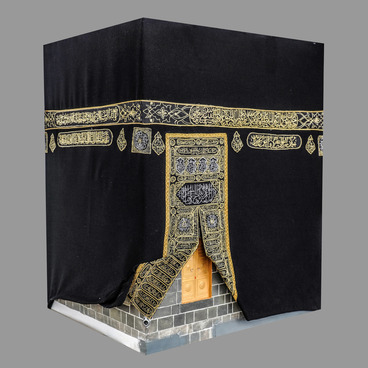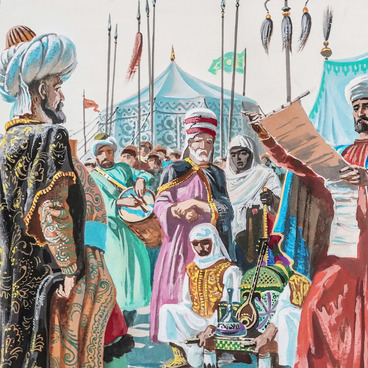This representative ceramic tile with an oriental ornament is an element of décor thrown away during the restoration. Currently, it is in the section dedicated to the activities of the Moslems of the Russian Empire in the city life of Saint Petersburg.
The 19th century features a burst of activity of Islam followers: they were building mosques, schools, madrasah, hospitals and asylums all over Russia. Tatar industrialists and merchants initiated and sponsored such construction. Saint Petersburg being a Russian capital and multi-confessional city with a significant Moslem community was also part of this movement.
At that time, Saint Petersburg did not have a mosque; despite numerous petitions by the Moslems, the city government officials found the reasons for refusal. In 1906, they finally allotted the land plot after Emir of Bukhara personally signed the petition (that year he received the Order of St. Andrew ‘The First-Called’ from the hands of Nikolay II). The Moslems created a special committee for fundraising, and they raised quite significant amount, though no one was hiding the fact that the major portion of the money required for construction came from Said ‘Abd al-Ahad Khan himself.
The official ceremony of laying the foundation was coincided with the jubilee date — on February 10, 1910, it was 25 years since Said “Abd al-Ahad became the Emir of Bukhara. Stepan Krichinsky, Alexander Gogen and Nikolay Vasiliev, well-known Russian architects designed the mosque. The first service was held after 3 years, when Russia celebrated the 300th anniversary of the reign of the House of Romanovs. At that time, the mosque was not yet completed — the internal finishing was done only by 1920. However, all this time the services were held.
After completion of construction and finishing, which took place in the difficult pot-revolutionary and post-war period, the mosque was fully functioning for 10 years. In 1930, when churches, mosques and temples were closed and their buildings turned mostly into warehouses, this mosque was also closed. It was not functioning for 26 years; the services resumed during the “thaw” period — in 1956.
Thanks to the talent of designers, the building was excellently integrated into the architecture of Saint Petersburg — the facing of the walls made of grey granite turned the mosque into a member of the family of the capital’s palaces, old-fashioned mansions and the Neva embankments. However, the minarets cladded with sky-blue ceramic tiles and the facades covered with eloquent Arabic ligature does not leave a chance for the mosque to escape attention.
The inner finish is traditionally wealthy — with a giant chandelier in the centre, with arches and columns cladded with green marble, and with the walls covered with magnificent ornament. This mosque is the biggest in Europe; it can hold up to 5 thousand believers simultaneously. According to the tradition, the ground floor is at the disposal of men, women pray in a smaller room upstairs. The next floor is allocated for the madrasah, where all those who wish to do so can take classes of Arabic and Tatar languages, as well as of the Islam basics. Mufti Jafar Ponchayev is the abbot of the mosque.
The 19th century features a burst of activity of Islam followers: they were building mosques, schools, madrasah, hospitals and asylums all over Russia. Tatar industrialists and merchants initiated and sponsored such construction. Saint Petersburg being a Russian capital and multi-confessional city with a significant Moslem community was also part of this movement.
At that time, Saint Petersburg did not have a mosque; despite numerous petitions by the Moslems, the city government officials found the reasons for refusal. In 1906, they finally allotted the land plot after Emir of Bukhara personally signed the petition (that year he received the Order of St. Andrew ‘The First-Called’ from the hands of Nikolay II). The Moslems created a special committee for fundraising, and they raised quite significant amount, though no one was hiding the fact that the major portion of the money required for construction came from Said ‘Abd al-Ahad Khan himself.
The official ceremony of laying the foundation was coincided with the jubilee date — on February 10, 1910, it was 25 years since Said “Abd al-Ahad became the Emir of Bukhara. Stepan Krichinsky, Alexander Gogen and Nikolay Vasiliev, well-known Russian architects designed the mosque. The first service was held after 3 years, when Russia celebrated the 300th anniversary of the reign of the House of Romanovs. At that time, the mosque was not yet completed — the internal finishing was done only by 1920. However, all this time the services were held.
After completion of construction and finishing, which took place in the difficult pot-revolutionary and post-war period, the mosque was fully functioning for 10 years. In 1930, when churches, mosques and temples were closed and their buildings turned mostly into warehouses, this mosque was also closed. It was not functioning for 26 years; the services resumed during the “thaw” period — in 1956.
Thanks to the talent of designers, the building was excellently integrated into the architecture of Saint Petersburg — the facing of the walls made of grey granite turned the mosque into a member of the family of the capital’s palaces, old-fashioned mansions and the Neva embankments. However, the minarets cladded with sky-blue ceramic tiles and the facades covered with eloquent Arabic ligature does not leave a chance for the mosque to escape attention.
The inner finish is traditionally wealthy — with a giant chandelier in the centre, with arches and columns cladded with green marble, and with the walls covered with magnificent ornament. This mosque is the biggest in Europe; it can hold up to 5 thousand believers simultaneously. According to the tradition, the ground floor is at the disposal of men, women pray in a smaller room upstairs. The next floor is allocated for the madrasah, where all those who wish to do so can take classes of Arabic and Tatar languages, as well as of the Islam basics. Mufti Jafar Ponchayev is the abbot of the mosque.



